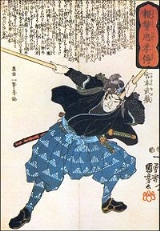
, Niten Dōraku, was a Japanese
swordsman and rōnin
. Musashi, as he was often simply known, became renowned through stories of his excellent swordsmanship in numerous duels, even from a very young age. He was the founder of the Hyōhō Niten Ichi-ryū
or Niten-ryū style of swordsmanship and the author of , a book on strategy, tactics, and philosophy that is still studied today.
The Way is shown in five books concerning different aspects. These are Ground, Water, Fire, Wind, and Void. The body of the Way of strategy from the viewpoint of my Ichi school is explained in the Ground book. It is difficult to realise the true Way just through sword-fencing. Know the smallest things and the biggest things, the shallowest things and the deepest things. As if it were a straight road mapped out on the ground, the first book is called the Ground book.
![]()
Second is the Water book. With water as the basis, the spirit becomes like water. Water adopts the shape of its receptacle, it is sometimes a trickle and sometimes a wild sea. ... If you master the principles of sword-fencing, when you freely beat one man, you beat any man in the world. The spirit of defeating a man is the same for ten million men. ... The principle of strategy is having one thing, to know ten thousand things.
![]()
Fifthly, the book of the Void. By Void I mean that which has no beginning and no end. Attaining this principle means not attaining the principle. The Way of strategy is the Way of nature. When you appreciate the power of nature, knowing the rhythm of any situation, you will be able to hit the enemy naturally and strike naturally. All this is the Way of the Void. I intend to show how to follow the true Way according to nature in the book of the Void.
![]()
I have been many years training in the Way of strategy, called Ni Ten Ichi Ryu, and now I think I will explain it in writing for the first time.
![]()
Strategy is the craft of the warrior. Commanders must enact the craft, and troopers should know this Way. There is no warrior in the world today who really understands the Way of strategy. There are various Ways. There is the Way of salvation by the law of Buddha, the Way of Confucius governing the Way of learning, the Way of healing as a doctor, as a poet teaching the Way of Waka, tea, archery, and many arts and skills. Each man practices as he feels inclined.
![]()

